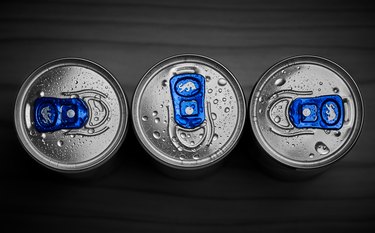
When the mid-day slump strikes, it can be tempting to reach for a caffeinated beverage like sugar-free Red Bull to help power you through the rest of the day. And while you may experience an immediate boost of energy, the ingredients in these drinks also come with some unpleasant side effects.
Sugar Free Red Bull
Video of the Day
As the popularity of energy drinks keeps increasing, understanding the potential side effects is important. In general, caffeine, in moderate doses, is relatively safe for most people. That said, being an informed consumer is critical when purchasing drinks like sugar-free Red Bull.
Video of the Day
Sugar-free energy drinks may lack the extra calories that come with fully-loaded drinks, but the sweetness used to replace the sugar also comes with its own risks. Sugar-free Red Bull and Red Bull Zero both contain aspartame and acesulfame potassium ("Ace-K" in the food industry). But Red Bull Zero has an additional sweetener, sucralose (Splenda), added to the product, according to the company website.
While the research is mixed on the safety and consequences of artificial sweeteners, Harvard Health points out that even though the FDA approval ruled out cancer risk, we really don't know what effect large amounts of these chemicals will have over many years. They also raise the concern about the consumption of diet drinks, and the artificial sweeteners, being connected to metabolic syndrome and increased risk of type 2 diabetes.
However, one of the primary ingredients in Red Bull Sugarfree, caffeine, can have adverse side effects, especially if consumed in excessive amounts. An October 2015 review of literature published in the International Journal of Health Sciences found that several studies show an increase in heart rate and arterial blood pressure after consuming energy drinks.
Side Effects of Caffeine
The main ingredient in many energy drinks is often caffeine, which makes sense since getting a quick boost of energy is the reason most people purchase drinks like Red Bull Sugarfree. Although caffeine does have some positive perks, when consumed in safe doses, it can also have some serious side effects when abused.
According to the U.S. Food and Drug Administration (FDA), 400 milligrams of caffeine per day is the recommended maximum for healthy adults. The regular-sized can of Red Bull Zero and Red Bull Sugarfree both contain 80 milligrams of caffeine, which is comparable to the amount of caffeine in a cup of coffee.
If you drink one of two cups of coffee in the morning, followed by a few energy drinks later in the day, you are now close to the maximum recommended amount of caffeine by the FDA. And while some people are able to manage this much caffeine, others may experience negative side effects with even less amounts of caffeine.
Some of the more common side effects of caffeine, according to the FDA, include:
- Anxiousness
- Headache
- Nausea
- Increased heart rate
- Difficulty sleeping
- Jitters
How quickly you experience any of these side effects depends on a few factors including the amount you drink and your bodyweight. But in general, caffeine reaches maximum plasma concentration 15 to 120 minutes after ingestion, according to a May 2017 study published in Frontiers of Psychiatry, which means, the effects of caffeine become noticeable anywhere from 15 minutes to two hours after consumption.
Other Ways to Boost Energy
Consuming energy drinks like sugar free Red Bull are relatively safe in moderation. However there are other ways to boost your energy levels. If you want to avoid the artificial sweeteners and other ingredients in energy drinks, but still want the benefit of caffeine, opt for a cup of coffee.
When it comes to sugar free Red Bull vs coffee, the clear winner is coffee, as long as you drink it without added sugar. Black coffee with minimal amounts of cream and no added sugar, contains less ingredients than an energy drink. Plus, when consumed in moderation, the potential side effects are minimized, according to the FDA.
Getting outdoors for a walk or to the gym for a quick workout is another way to boost your energy. Even if you're dragging, and exercise is the last thing you want to do, regular physical activity can improve your muscle strength and boost your endurance, according to the Mayo Clinic. And the best part? It doesn't take hours to reap the rewards of moving your body. Even a short, 15 to 20-minute walk during your lunch break is enough to get your blood flowing.
Taking stock of your diet is also key when determining a lack of energy. For optimum health, the Academy of Nutrition and Dietetics recommends eating regularly, balancing your plate with all the food groups and removing what they call "energy zappers," which includes foods with added sugars such as soda and energy drinks.
- International Journal of Health Sciences: "Energy Drink Consumption: Beneficial and Adverse Health Effects"
- U.S. Food and Drug Administration: "Spilling the Beans: How Much Caffeine is Too Much?"
- Frontiers in Psychiatry: "The Safety of Ingested Caffeine: A Comprehensive Review"
- Red Bull Website: "Sugarfree Wiings"
- Harvard Health: "Artificial Sweeteners: Sugar-Free, But at What Cost?"
- Academy of Nutrition and Dietetics: "Eating to Boost Energy"
- The Mayo Clinic: "Exercise: 7 Benefits of Regular Physical Activity"
- Red Bull: Red Bull Sugar Free
- Potsdam University: Alcohol Problems and Solutions; About Your Host